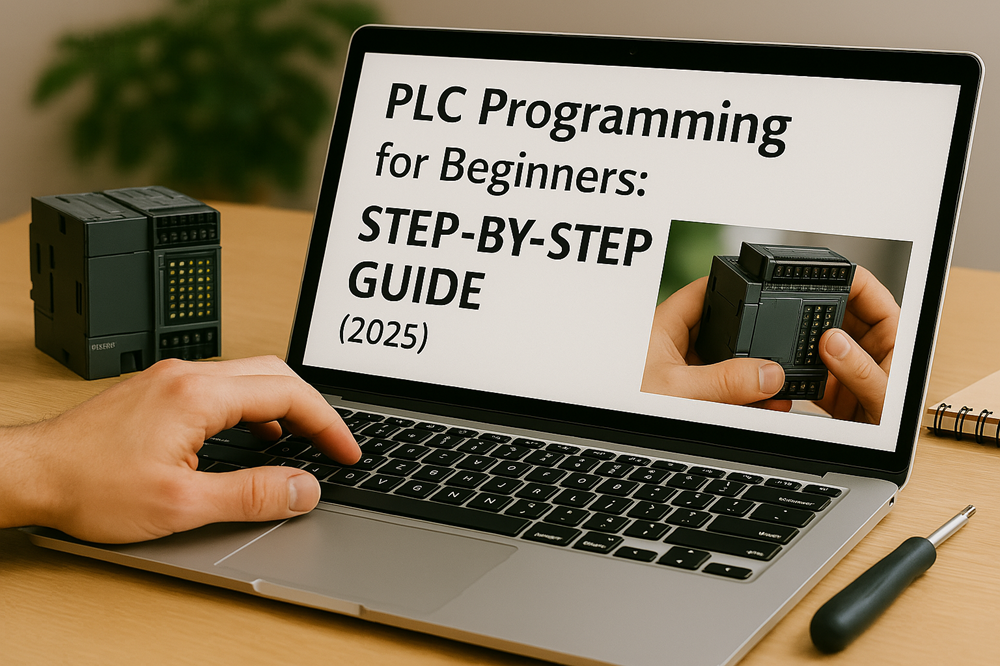PLC Programming for Beginners: Step-by-Step Guide (2025)

Computerized industrial automation is the contemporary world in which PLC programming is an essential professional competence and, of course, a very useful subject to study as well. You are new in the world of PLCs, and you do not know where to start? You should have just gotten a roadmap.
This step-by-step beginner tutorial explains in simple language and with real-life examples how PLC programming can be simplified to understand. If you are a student, technician, or just an interested self-taught learner, this is your way into a realm of smart automation.
What is PLC programming?
PLC programming refers to making up a set of directions that is supposed to be followed by a Programmable Logic Controller (PLC) and used to control machines or processes.
You do not physically move switches back and forth or press buttons on a machine; rather, you program the logic to indicate how and when to act. It is comparable to installing a brain into your system—logical, responsive, and repeatable.
PLC programming for beginners: what is PLC programming, how to learn PLC, ladder logic tutorial, PLC automation training
Step 1: Understand the Basics of a PLC
Before you place the first line in your code, you must comprehend what a PLC is as well as its components.
- CPU (Central Processing Unit): performs the program logic.
- Input Module: Takes the input of switches, sensors, and buttons.
- Output Module: Signals sent to motors, lights, relays, etc.
- Power Supply: supplies the PLC system with the necessary voltage.
- Programming Device: A laptop or a PC containing some programming software.
PLCs are constructed to be reliable, fast, and suited to harsh conditions, thus being suitable in a factory, plant, and even smart buildings.
Step 2: Choose Your Programming Language:
Ladder logic is used by most beginners and looks like electrical relay diagrams, making it easy to understand for electricians and control technicians.
There are also such other popular languages:
- Function Block Diagram (FBD)
- Structured Text (ST)
- Instruction List (IL)
- Sequential Function Charts (SFC)
Now, to begin with, use ladder logic. It is graphic, readable, and supported by the vast majority.
Step 3: Install PLC Programming Software:
Different PLC brands use different software. Here are a few industry-standard platforms:
| PLC Brand | Software | Notes |
|---|---|---|
| Siemens | TIA Portal | Used for S7-1200/1500 PLCs |
| Allen-Bradley | RSLogix/Studio 5000 | Used for MicroLogix and CompactLogix |
| Mitsubishi | GX Works | User-friendly for beginners |
| Delta / Omron | WPLSoft / CX-Programmer | Ideal for learning |
Tips: On the majority of platforms, there are simulators, which means you can practice your logical thinking without the real hardware.
Step 4: Learn Ladder Logic—Your First Program:
[Start Button] —| |———( ) — [Motor]
| |
[Stop Button] —-|/|————–|
Key Symbols:
- | | = Normally open contact (e.g., start button)
- |/| = Normally closed contact (e.g., stop button)
- ( ) = Output coil (e.g., motor
What it is:
- Pressing Start is to energise the motor.
- When Stop is pressed, the circuit is broken, and the circuit is terminated.
ladder logic basics, PLC start-stop program, beginner PLC code, PLC programming examples,
Step 5: Download the Program to PLC:
After you have the logic in place:
- Install the PLC and plug your PC into it through USB or Ethernet.
- Launch the software and make your program.
- Download it to the PLC.
- Press Run mode and watch your logic as it happens.
See the I/O transforming right before your eyes and work the logic with real buttons or bombardiers.
Step 6: Simulate and Troubleshoot:
The simulation happens prior to pressing a button on a live system, and it is your best friend. To use simulation tools on the software:
- The change in trigger inputs
- Monitor behaviour of the output
- See whether the reasoning is flawed
- Timing and sequencing information fine-tuning
PLC troubleshooting, PLC simulation, PLC software download, test ladder logic
Step 7: Apply to Real Projects:
With simple logic worked out, see whether you can put them into practice by doing mini-projects in real life:
- Traffic Light Controller
- Questionnaire on Water Level Monitor
- Automation of Conveyor Belt
- PID Temperature Controller
- Home Automation using PLC
Begin at a basic level, and go up the ladder. As you become more comfortable, use timers and counters and analog I/O and sensors.
Bonus Tips to Succeed as a Beginner in PLC Programming:
- Repetition daily—part of the long-term retention.
- Use Simulators—They are safe, free, and full of information.
- See Video Tutorials—Visual learning promotes learning.
- Eligible for Certification Course—They greatly enhance your resume.
learn PLC online, free PLC course, PLC programming certification, PLC jobs for beginners
Real-World Use Cases of PLCs:
- Factory lines that produce cars using robotic arm
- Measuring liquid levels in bottles and capping bottles for bottling plants.
- Intelligent elevators controlling floors & emergency systems
- Solar tracking optimization of panel angle
- Living area systems integration, illumination, and air conditioning.
PLCs aren’t the future; they’re working in the here and now.
Good luck for your future, and thank you!
